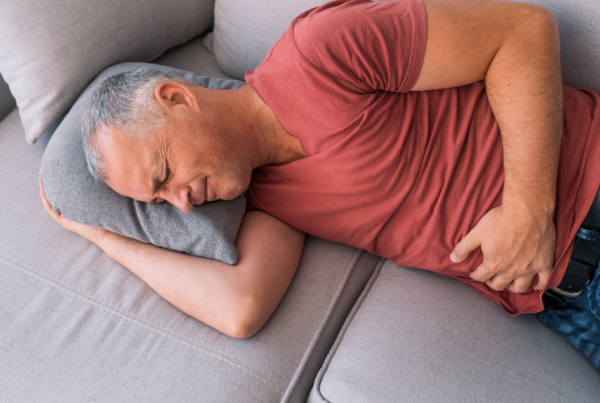Constipation
Move Better. Live Fuller. Your Wellness Journey Starts Here.
Schedule a FREE Discovery Call!
What Is Constipation?
Constipation is a common condition that most people are familiar with, however the term itself refers to a broad range of symptoms all relating to bowel movements. It can be experienced in a few different forms with varying symptoms.
Identifying the specific symptoms and characteristics of the condition can help providers better understand possible causes and treatment options for their patients. Some common types of constipation include:

Dyschezia: Difficulty with the act of emptying the bowels, often associated with straining, pain, or obstruction. This refers to general constipation when referring to adults.
Slow Transit Constipation: Reduced motility of the large intestine, which results in an abnormally slow passage of stool. Food moves slower through the digestive tract, and stool takes longer to pass through the colon. This causes less frequent bowel movements.
Functional Constipation: This is usually a problem with evacuation; it includes difficulty passing stool, hard stool, incomplete evacuations, and infrequent bowel movements.
Chronic Idiopathic Constipation (CIC): This refers to symptoms with no obvious cause; in which bowel movements are irregular. This includes Irritable Bowel Syndrome (IBS), which is often accompanied by abdominal pain.
While many may simply consider constipation as being unable to empty the bowels properly, some more specific symptoms can include:
- Infrequent bowel movements (less than 3 per week).
- Hard, dry, or lumpy stools that are difficult to pass and may cause straining.
- Straining or significant discomfort while emptying bowels.
- The feeling of incomplete evacuation (not all stool has passed).
- The sensation that there is something blocking stool from passing through.
- The need to use manual maneuvers or pressure to allow an easier passing of stool.
- A feeling of fullness or bloating in the abdomen.
- Loss of appetite (caused by a feeling of fullness or bloating).
- Abdominal pain or discomfort that is relieved after a bowel movement.
- Nausea or an upset stomach.
- Fatigue or a feeling of lethargy.
What Causes Constipation?
Constipation can be caused by a wide range of dietary or lifestyle choices, as well as underlying conditions. It can also differ in intensity, ranging from acute to chronic depending on the individual.
In terms of lifestyle factors, people who do not include enough fiber and fluids in their daily diet, who do not engage in regular physical activity, or who delay their bowel movements may be more likely to experience constipation. A change in your regular routine, such as traveling or changing your regular meal times may also cause symptoms. Other causes can include:
Medication or supplements
- Pain medications: Often contribute to constipation, especially opioids.
- Antidepressants: Some types may cause constipation.
- Antacids: Particularly antacids that contain calcium or aluminum.
- Iron supplements: Can cause or worsen constipation.
- Calcium Channel Blockers: For high blood pressure or heart conditions.
- Anticholinergics: Affect movement in the digestive tract.
- Laxatives: Prolonged use can create reliance.
Hormonal changes
- Menstruation
- Pregnancy
- Perimenopause/menopause
Psychological factors
- Stress
- Anxiety
- Depression
Health conditions
- Hyperthyroidism
- Diabetes
- Parkinson’s disease
- Crohn’s disease
Aging
- A change in diet, physical activity, and the presence of other conditions as you move through later stages of life can affect bowel health.
Physical Therapy for Constipation
Treatment for constipation will depend on the specific diagnosis given by your provider. It may include dietary and lifestyle changes, such as integrating more fiber and fluids into your diet, exercise, and altering medication use. Physical therapy can also be an effective form of treatment and management of symptoms, especially for patients with gastrointestinal disorders, IBS, or pelvic floor dysfunction.
Pelvic floor dysfunction can be a large contributor to constipation, as it can make patients struggle to complete a bowel movement. This can be due to poor coordination of the pelvic floor muscles, such as being unable to properly relax and allow stool to pass. Pelvic floor physical therapy can help solve your pelvic floor problems by helping you retrain your muscles and regain proper muscle coordination.
Additionally, physical therapy can help make IBS more manageable by reducing the severity or frequency of symptoms. This can be done with a variety of treatments to reduce stress and pain in the abdomen, such as creating an individualized routine for exercise, behavioral modifications, and other treatments. Using physical therapy to help relieve IBS symptoms can often include recognizing possible pelvic floor dysfunctions, too.
If you experience symptoms of constipation, you should speak with a physical therapist to see what treatment is suitable for you! If your provider deems physical therapy appropriate for your needs, you may receive one or more of the following treatments:
- Cupping
- Manual therapy
- Exercise prescription
- Behavioral modifications
- Neuromuscular re-education
- Biofeedback
- Therapeutic activity
Constipation is a common condition that most people are familiar with, however the term itself refers to a broad range of symptoms all relating to bowel movements. It can be experienced in a few different forms with varying symptoms.
Identifying the specific symptoms and characteristics of the condition can help providers better understand possible causes and treatment options for their patients. Some common types of constipation include:
Dyschezia: Difficulty with the act of emptying the bowels, often associated with straining, pain, or obstruction. This refers to general constipation when referring to adults.
Slow Transit Constipation: Reduced motility of the large intestine, which results in an abnormally slow passage of stool. Food moves slower through the digestive tract, and stool takes longer to pass through the colon. This causes less frequent bowel movements.
Functional Constipation: This is usually a problem with evacuation; it includes difficulty passing stool, hard stool, incomplete evacuations, and infrequent bowel movements.
Chronic Idiopathic Constipation (CIC): This refers to symptoms with no obvious cause; in which bowel movements are irregular. This includes Irritable Bowel Syndrome (IBS), which is often accompanied by abdominal pain.
While many may simply consider constipation as being unable to empty the bowels properly, some more specific symptoms can include:
- Infrequent bowel movements (less than 3 per week).
- Hard, dry, or lumpy stools that are difficult to pass and may cause straining.
- Straining or significant discomfort while emptying bowels.
- The feeling of incomplete evacuation (not all stool has passed).
- The sensation that there is something blocking stool from passing through.
- The need to use manual maneuvers or pressure to allow an easier passing of stool.
- A feeling of fullness or bloating in the abdomen.
- Loss of appetite (caused by a feeling of fullness or bloating).
- Abdominal pain or discomfort that is relieved after a bowel movement.
- Nausea or an upset stomach.
- Fatigue or a feeling of lethargy.
Constipation can be caused by a wide range of dietary or lifestyle choices, as well as underlying conditions. It can also differ in intensity, ranging from acute to chronic depending on the individual.
In terms of lifestyle factors, people who do not include enough fiber and fluids in their daily diet, who do not engage in regular physical activity, or who delay their bowel movements may be more likely to experience constipation.
A change in your regular routine, such as traveling or changing your regular meal times may also cause symptoms.
Other causes can include:
Medication or supplements
- Pain medications: Often contribute to constipation, especially opioids.
- Antidepressants: Some types may cause constipation.
- Antacids: Particularly antacids that contain calcium or aluminum.
- Iron supplements: Can cause or worsen constipation.
- Calcium Channel Blockers: For high blood pressure or heart conditions.
- Anticholinergics: Affect movement in the digestive tract.
- Laxatives: Prolonged use can create reliance.
Hormonal changes
- Menstruation
- Pregnancy
- Perimenopause/menopause
Psychological factors
- Stress
- Anxiety
- Depression
Health conditions
- Hyperthyroidism
- Diabetes
- Parkinson’s disease
- Crohn’s disease
Aging
- A change in diet, physical activity, and the presence of other conditions as you move through later stages of life can affect bowel health.
Treatment for constipation will depend on the specific diagnosis given by your provider. It may include dietary and lifestyle changes, such as integrating more fiber and fluids into your diet, exercise, and altering medication use.
Physical therapy can also be an effective form of treatment and management of symptoms, especially for patients with gastrointestinal disorders, IBS, or pelvic floor dysfunction.
Pelvic floor dysfunction can be a large contributor to constipation, as it can make patients struggle to complete a bowel movement.
This can be due to poor coordination of the pelvic floor muscles, such as being unable to properly relax and allow stool to pass.
Pelvic floor physical therapy can help solve your pelvic floor problems by helping you retrain your muscles and regain proper muscle coordination.
Additionally, physical therapy can help make IBS more manageable by reducing the severity or frequency of symptoms.
This can be done with a variety of treatments to reduce stress and pain in the abdomen, such as creating an individualized routine for exercise, behavioral modifications, and other treatments.
Using physical therapy to help relieve IBS symptoms can often include recognizing possible pelvic floor dysfunctions, too.
If you experience symptoms of constipation, you should speak with a physical therapist to see what treatment is suitable for you!
If your provider deems physical therapy appropriate for your needs, you may receive one or more of the following treatments:
- Cupping
- Manual therapy
- Exercise prescription
- Behavioral modifications
- Neuromuscular re-education
- Biofeedback
- Therapeutic activity
You can learn more about these treatments on our Treatments Page.





